2007 VOLKSWAGEN GOLF center console
[x] Cancel search: center consolePage 9 of 444
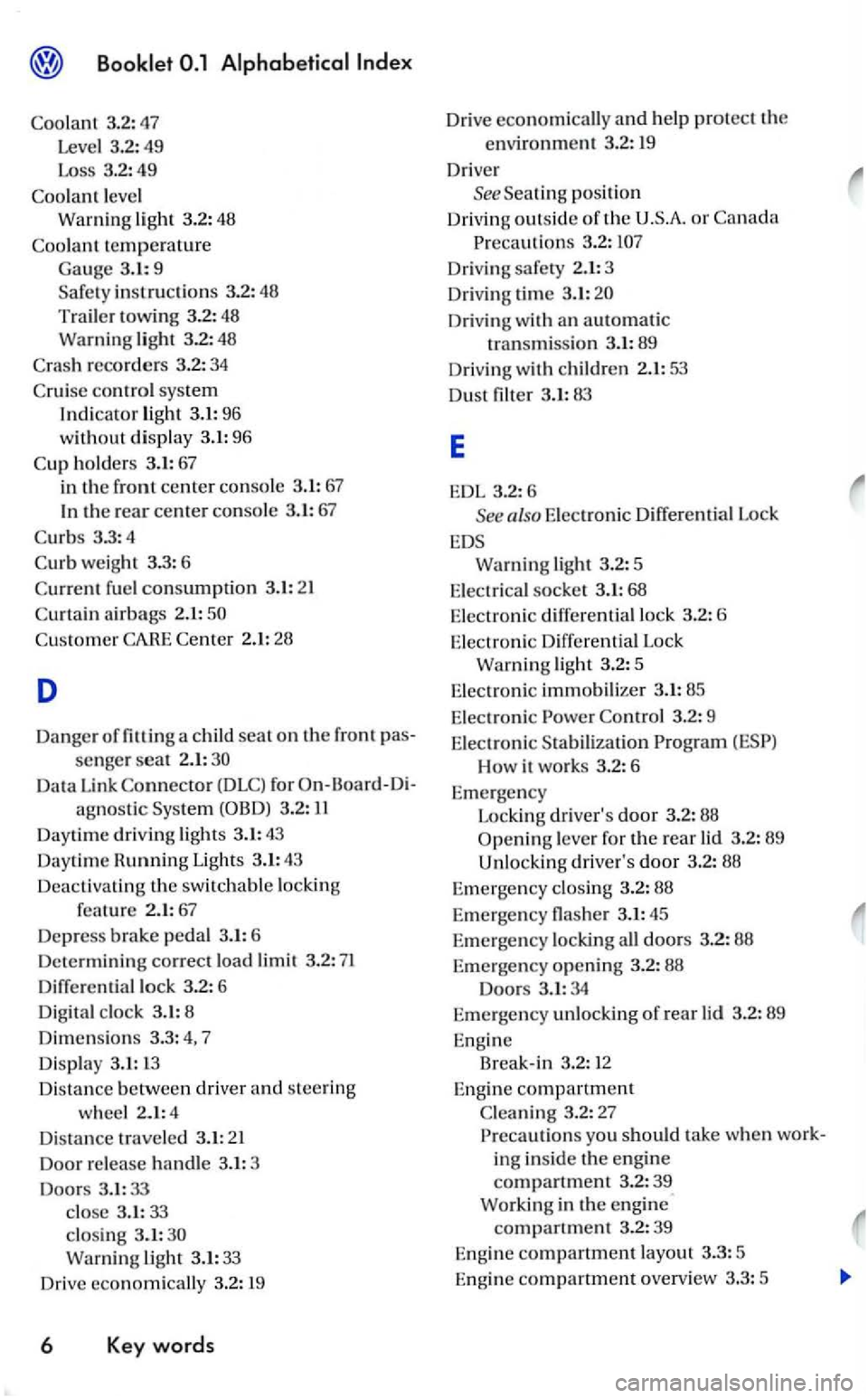
Coolant 3.2: 47
Level 3.2:
49
Loss 3.2:49
Coolant leve l
Warning light 3.2: 48
Coolant temperature
Gauge 3.1:9 Safe ty instru ctions 3.2:48
Trail er towing 3.2: 48
Warning light 3.2 : 4 8
C
ras h recorders 3.2: 34
C rui
se control system
Indicator light 3.1:96
without display 3.1: 96
C up ho ld ers 3.
1: 67
in the front center consol e 3 .1: 67
the rear center console 3.1:67
Curbs 3.3:4
Curb weight 3.3 : 6
C
urrent f u el con sumptio n 3.1:21
C
urtain airbags 2.1:
Custome r Center 2.1: 28
D
Danger of fittin g a child seat on the front pas
senger seat 2.1:
Daytime dri ving lights 3.1:4 3
Daytime Hunning Light s 3.1: 43
D
eactiv ating the switchabl e lockin g
2.1: 67
Depress brake ped al 3.1: 6
Determining correct load l im it 3.2: 71
Diff
erential lock 6
Digit al cl
ock 3.1:8
Dimensio n s 3.3: 4, 7
Disp la y 3.1: 1 3
D is t
ance b etween driver and steerin g
w h
eel 2.1:4
D is ta n
ce travele d 3.1: 21
Door re lease h andle 3.1: 3
Doors 3.1:33
close 3.1: 33 closing 3.1: Warning li gh t 3.1: 33
Drive economically 3.2: 19
6 Key words
Drive economic all y and he lp protect the
environment 3.2: 19
Driv er See Seating position
Drivin g outside of the
Driving safety 2.1: 3
Driving lime 3
.1:
E
EDL 3.2:6
See also Electronic Differ ential Lock
Warning light 3.2:5
Electrical socket 3.1: 68
E
lectronic diff ere nti al lock 3.2: 6
Electroni c Differential Lock
Warning light 3.2: 5
Ele c
tronic immobilizer 3.1:85
E l
ectronic Co ntrol 3.2: 9
E l
ectronic Stabilization
How it works 3.2: 6
Eme rge ncy
L
ockin g driver's door 3.2: 88
Opening l eve r for the rear lid 3.2: 89
Unl ocki ng
driver's door 3.2: 88
Em ergency closing 3.2: 88
E m er
gency nasher 3.1: 45
E m
ergency locki ng all doors 3.2: 88
Emergency ope nin g 3.2: 88 Doors 3.1: 34
Emer gency
unlocking of rear lid 3.2: 89
E ng
ine Break-in 3.2: 12
Eng in e compartment
Cleaning 3.2 :27 you should take when work
i
ng in sid e the e ngin e
compartment 3.2:39 Work ing in the engine
compartment 3.2: 39
E n g in e
compartment la yout 3.3 : 5
E n
gine compartment overview 3.3: 5
Page 236 of 444
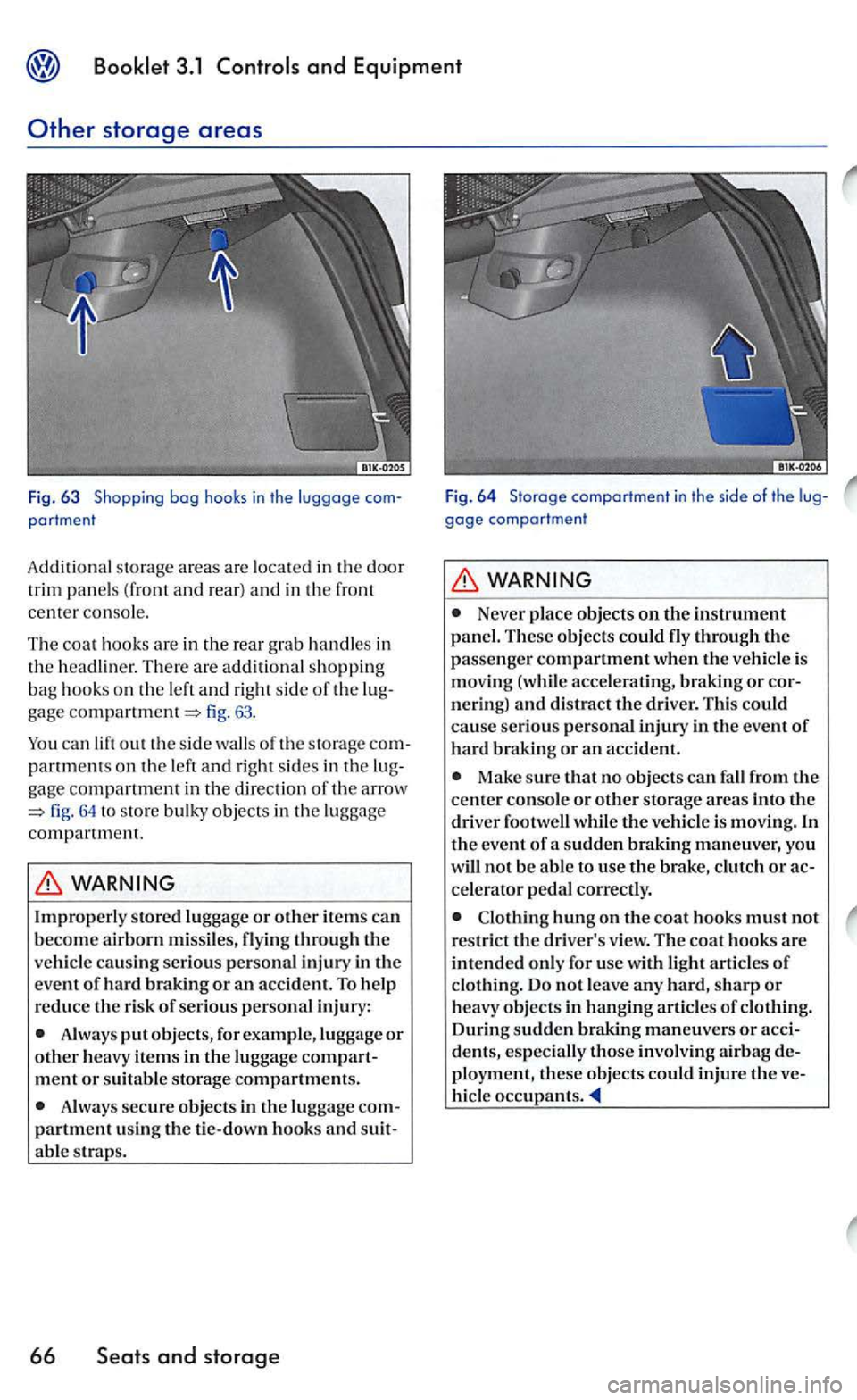
and Equipment
Other storage areas
Fig. 63 Shopping bog hooks in the luggage portment
Additiona l s torage areas are located in the door
trim panel s (f ront and rear ) and in the front
center console.
The coat hooks are
in the rear grab hand le s in th e There are add itional shopping
bag hook s on the and right side of the fig. 63.
out the s ide of the storage partm ent s on the and right sides in the
fig. 64 store bulky objects in the luggage
com partm ent.
Always put objects, for example, lug gage or other heavy items in the luggag e compartment or suitabl e storage compartments.
Always secure objects in the lu ggage partment using the tie-down hooks and able straps.
66
gage comportment
Never place objects on the instrument
panel. These objects could fly through the
passeng er compartm ent when th e is mov ing (w hile acce lerating, braking or n ering) and
Make sure that no objects fall from the cente r console o r other sto rage areas into the
dri ver footwell while the is m ov ing. In the event of a sudden brakin g maneuver, you
w ill not be able to usc tl1e brake,
hung on tl1e coat hooks must not rest rict the dri ver's view . The coat hooks arc intended only for usc with light of
of During sudden braking maneuvers or acci-
d e nts, especially those inv olv in g airbag de
ployment , these objects could inj ure the ve-occupants.
Page 237 of 444
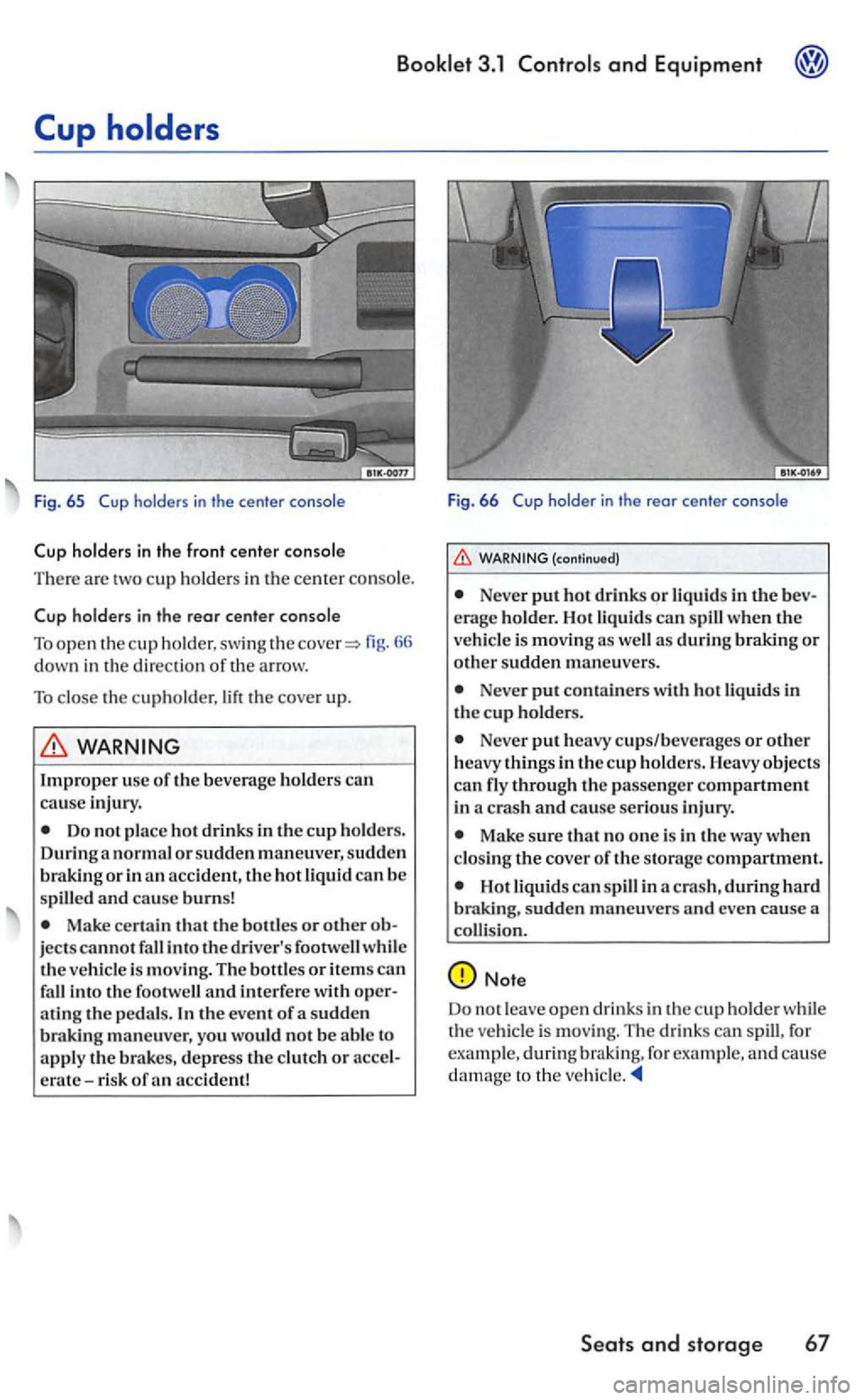
Booklet 3.1 Controls and Equipment
Fig . 6 5 holder s in the center console
66 down in th e dir ection of th e arrow.
To close the cupholder, lift the cove r up.
WARNING
Improper use of the be verage holders can
caus e injury .
Do not place hot drinks in the cup holders.
During a normal or sudden maneuver, s udd en
brakin g or in an accident , th e hot liquid can b e
s p ill ed and ca use burns!
Make certain that the bottles or other ject s cannot fall into tl1e driver 's footw ell whil e the vehicle is moving . The bottles or items can fall into the footwell and interfere with ating the ped als. In the event of a sudden
braking maneuve r, you would not be ab le to
apply the brakes, depres s the clutch or
(con tinued)
Neve r put hot drinks or liquid s in the era ge holder. Hot liquid s can spill when the
ve hicl e is moving as well as during brakin g or other sudden maneuver s.
Never put contai ners witl1 hot liquid s in
th e cup hold ers.
Neve r put heavy cups /b everages or ot her
h eavy things in the cup holders. Heavy objects
ca n fly through the passe nger compartment in a cra sh and cause serio us injury.
Make sure d1at no one is in the way when closing the cover of the storage compartment.
Hot liquid s ca n spill in a crash, during hard
Page 238 of 444
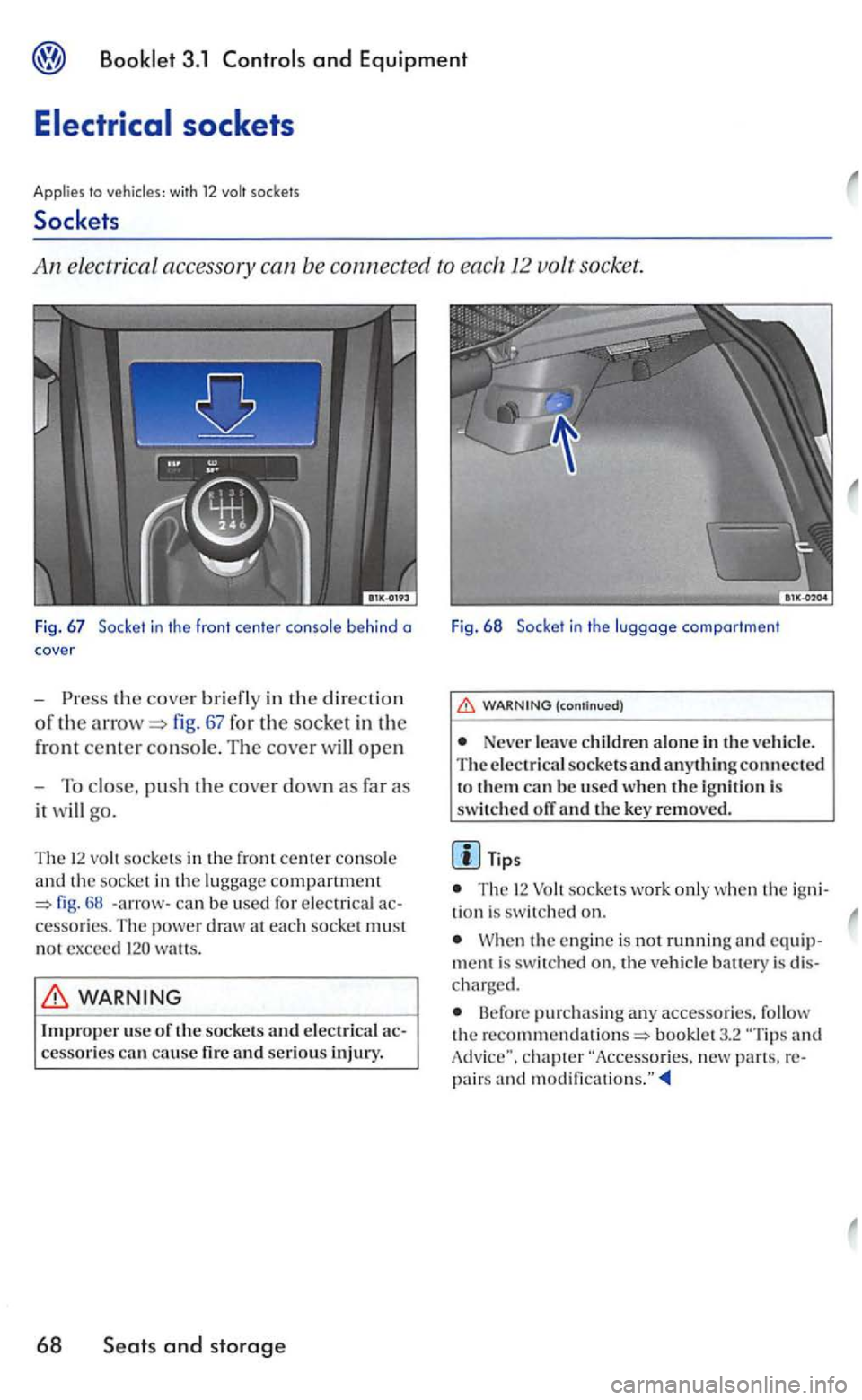
3.1 and Equipment
the cover briefly in th e directio n
of th e fig. 67 for the socket in the
front
center con so le. Th e cover will open
- To close, pus h the cove r down as far as
it will go.
Fig. 68 Socke t in th e luggage compo rtment
(continued)
Never le a ve children alone in the vehicl e.
T he electrical socke ts and anything connect e d
to the m can b e used when the ignition is switch ed orr and the key removed.
Tips
The 12 sock e ts wo rk onl y whe n th e igni -
The 12 sock e ts in the fr ont cente r console
a nd the so c ket in the lu ggage compartment
WARNING
Improper usc of the sockets and electrical cause fir e and serious injury.
68
the e ng ine is no t running and ment is s witc hed the vehicl e battery is c harged.
B efo re purchasing any accessorie s. follow th e booklet 3.2 and
Page 246 of 444
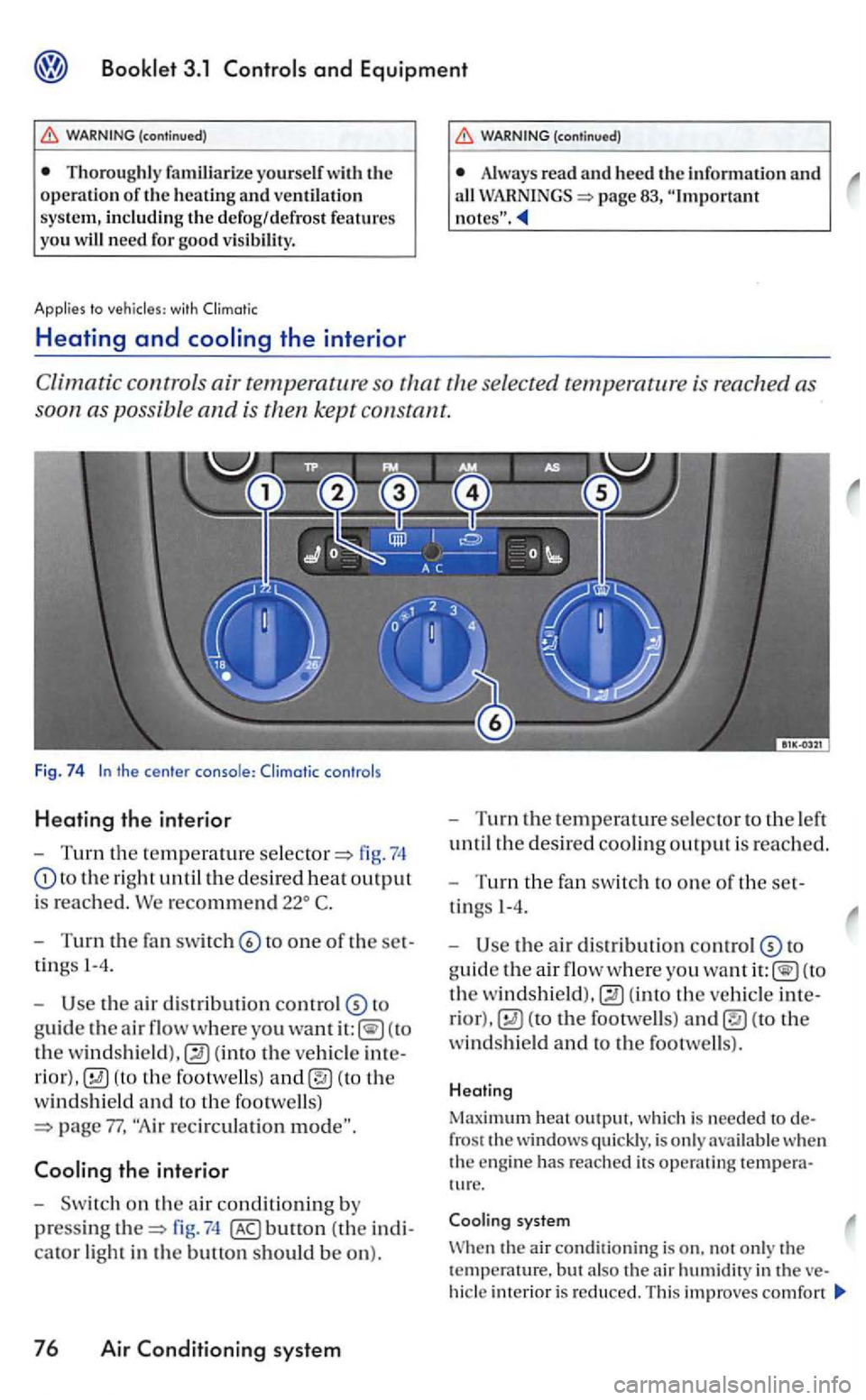
Thoroughly familiarize yourself with the operation of the heating and ventilation system, including the de fog ! defrost features you
Heating and
(continued)
Always read and heed the informati o n and
all page 83,
Climatic controls air temperature so that
the center console: Climatic controls
Heating the interior
Tu rn the te mperature g. 74
to the right until th e desired heat output
is reached. We recommend C.
Turn the fa n switch to one of the set
tin gs
l-4.
Use the ai r distribution to
guide the a ir
the
(to the
w
inds hi eld an d to the footwells)
77, recircu lation
fig. 74 (the indi
cato r
light in the button should be on).
76 Air system
Turn the t emperature selector to the left
until
the d esired cooling output is reached.
Turn the fan switch o ne of th e set
tings
l -4.
Use the to
g uid e
the air flow where you want (to
th e
the footwells)
which is needed to defrost the windows qu ickly, is only available when the en g in e has reached its operating temperature.
Coaling system
the air conditionin g is o n. not o nl y th e
Page 247 of 444
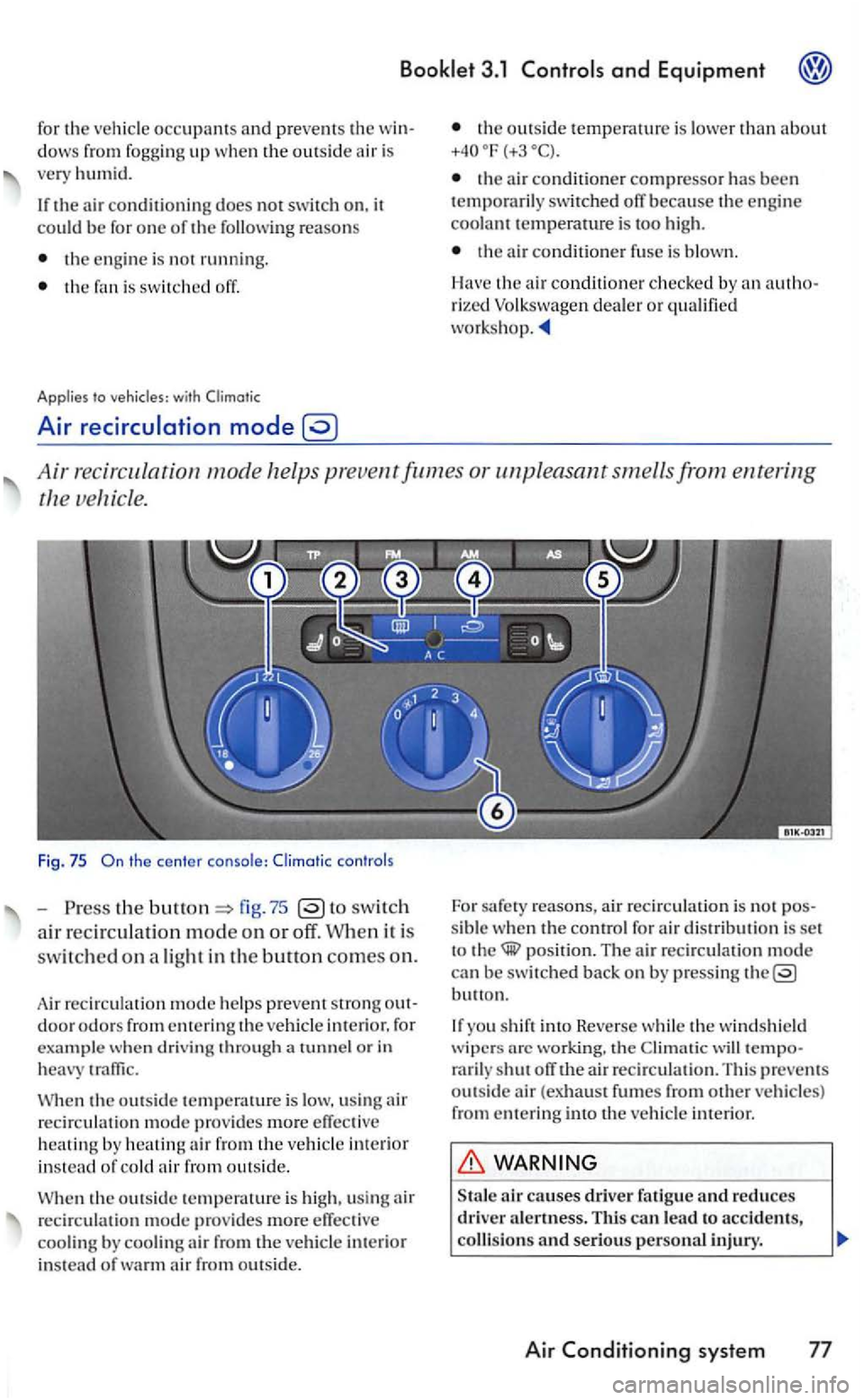
3.1
for the veh icle occupnnt s and prevents the w in
d ows from fogging up when the outside air is
very humi d.
If the air conditioni ng does not swit ch on, it coul d
the engine is not runni ng.
th e fa n is swi tc h ed off.
Applies to vehicles: with Climatic
Air recirculation
th e outside temperature is lower than about
(+3
th e ai r conditioner compressor has temporarily switched off because the engine coolant te m perature is too high.
the air conditioner fuse is blown.
Have th e air
condit ioner ch ecked b y an au th o
r ized Volk swage n dealer or qualified
wor ks hop.
Air recirw lario n m od e help s preven r fumes or unpleasant smells from en te ring
th e vehicle .
Fig. 75 the center console: C limatic controls
-the fig. 75 swit ch
a
ir r ecircu latio n mode on or off . W hen it is
swit ched o n a lig h t in th e butto n comes on.
A
ir recir cu latio n mode helps preve nt stro ng outdoor odors fro m ente rin g the ve hicl e interior. for exampl e when driving through a n mnel or in heavy
the outside temperatu re is low. u sing air
recircu la ti on mode prov ides more e ffective
heatin g by heating air f ro m the vehicle int erio r
in ste a d o f cold air from outs ide.
the o utside tempe rature is hi gh, using ai r
recircu lation mode prov id es more effective coolin g by cooling air fro m the ve hicle interior in stead of warm a ir from outside.
For sa fety reasons, a ir reci rc u la tio n is not possibl e when th e control for air di stributio n is set
to positio n. The air reci rculation mode can be switched back on by p ressing butto n.
yo u sh if t into Reverse whil e the windshi eld
w ip ers ore worki ng. the C lima tic tempo rarily shut off the ai r recirc ulat io n . This prevents outs ide air (exhaust fumes from other vehicles)
from entering into the vehicle interior.
air causes drive r fa ti gue and reduces driver alertness. This can lead to accidents,
Air Conditioning system 77
Page 341 of 444
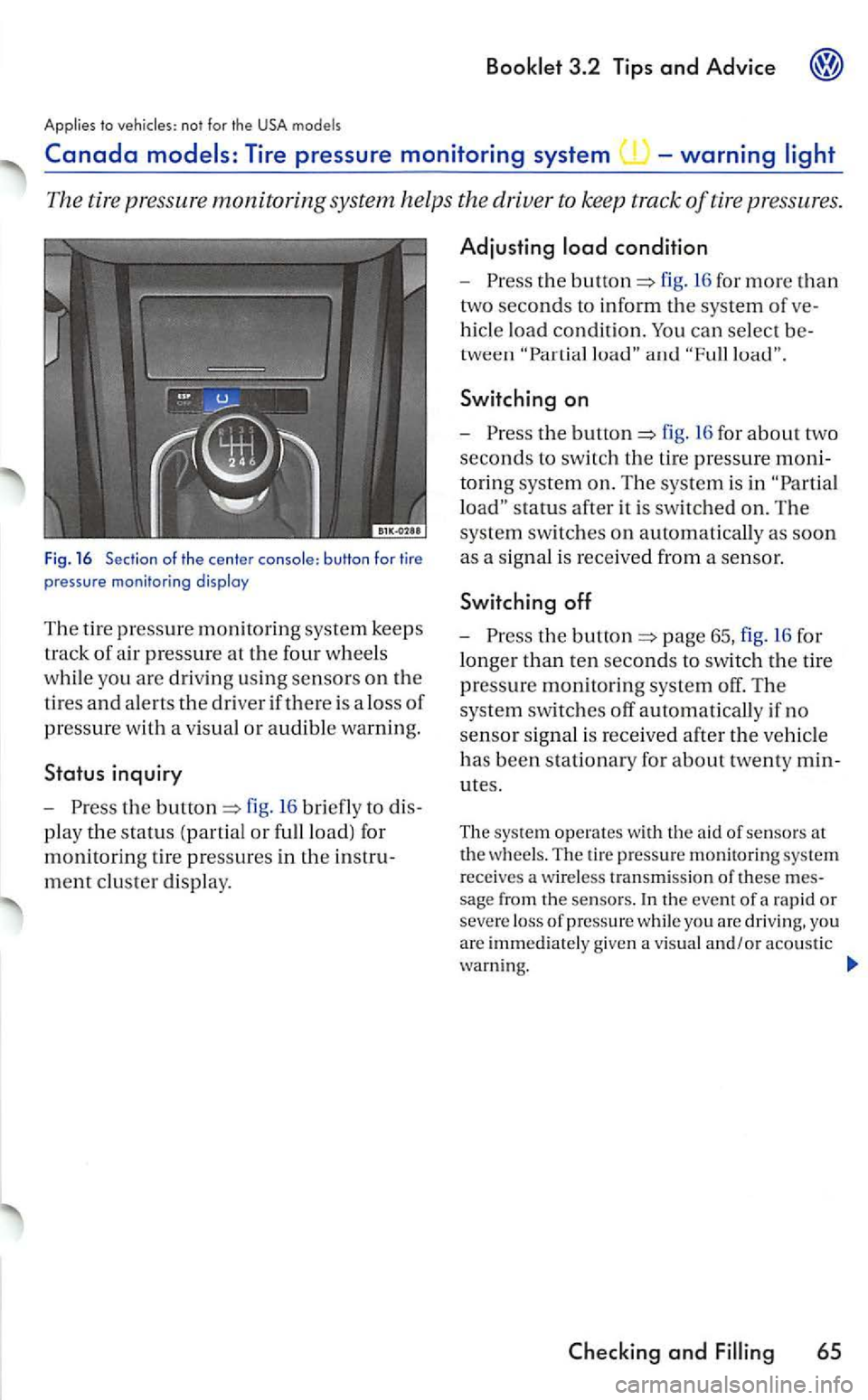
to the USA models
The tire pressure monitoring system helps the driver to keep track of tire pressures.
Fig. 16 Section of the center console: button for tire
p ressure monitoring disploy
T he tir e pressure monitoring system keep s
track
of air pressure at the four wheels
w hil e yo u
are driving using sen so rs on th e
tir
es and alerts the dri ver if th ere is a lo ss of
pressure with a visual or audibl e warning.
Status inquiry
-
play the status (partial or full load) for
m
onito ring tir e press ures in the
ment clu ster display.
Adjusting
the fig. 16 for more than
two seconds to inform th e system of
hicle load condition.
Switching on
-the fig. 16 for about two
seconds to switch the tire press ure
tori ng syste m on. The system is in
after it is switched o n. The
system
switches on autom atic ally as soon
as a sig nal is receive d from a sensor.
Switching off
-page 65, fig. 16 for
lo nger than te n seconds to switch th e ti re
pressure monito ring system off. The
system switches off automatically if no
sensor sig na l i s received aft e r th e vehicle
has been statio nary for about twenty
th e a id of se nso rs at t h e w heels . The tir e pressure monitoring syste m
rece ives a wireless transmissio n of these sage from the senso rs. In the event of a rapid or severe loss of pressu re wh ile yo u are driving, you are immediately given a visual and/or acoust ic
warning .
65